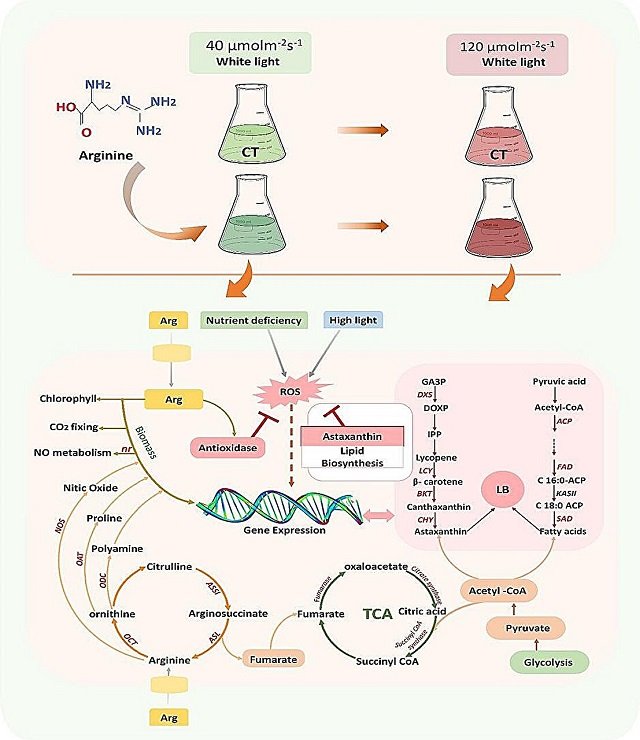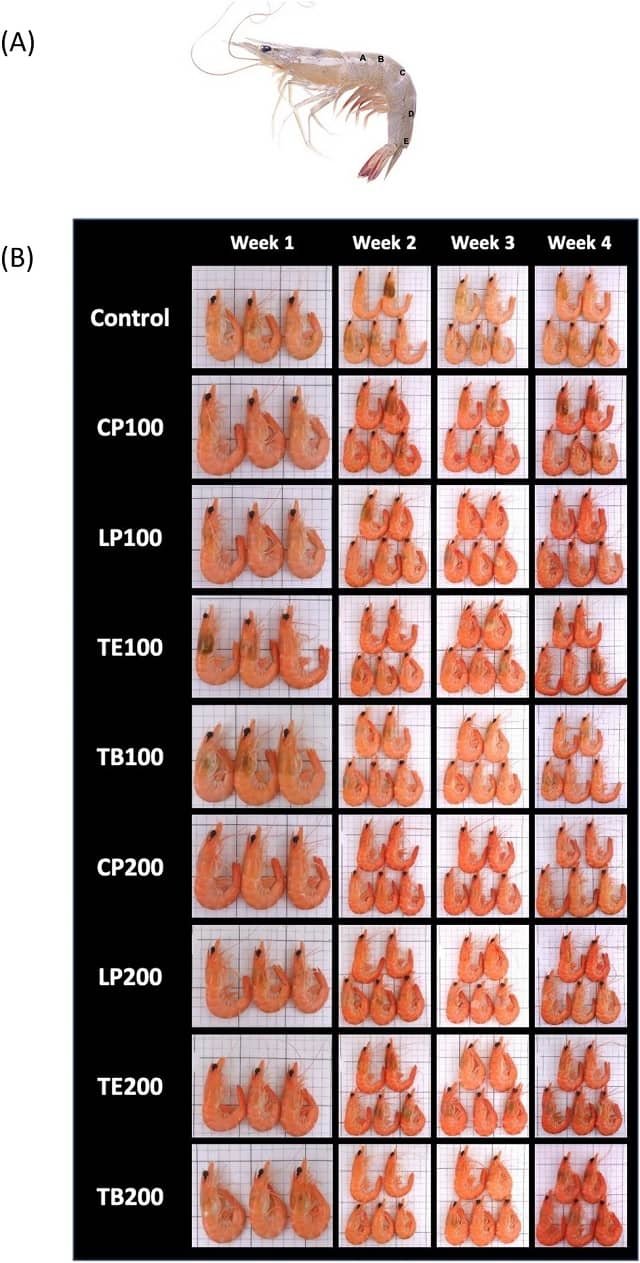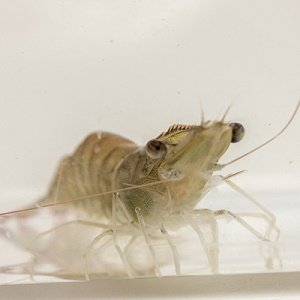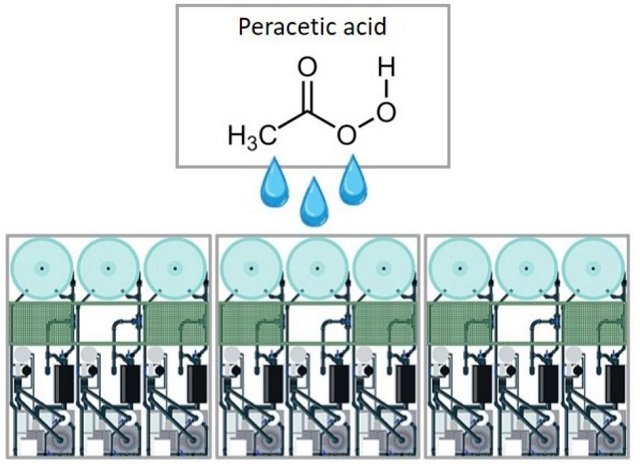
Haematococcus pluvialis, a microalgae known for its powerful antioxidant astaxanthin, holds immense promise for various industries. However, maximizing the simultaneous production of biomass, astaxanthin, and lipids while minimizing costs remains a challenge.
A new and intriguing research sheds light on the potential of arginine, an easily available and relatively inexpensive amino acid, as a potent bio-stimulant for Haematococcus pluvialis.
A team of researchers led by Prof. Huang Qing from the Hefei Institutes of Physical Science at the Chinese Academy of Sciences (CAS), and involving researchers from the University of Science and Technology of China, Anhui Jianzhu University, and Mansoura University, has demonstrated that arginine supplementation can enhance the growth and astaxanthin production of Haematococcus pluvialis (H. pluvialis).
Astaxanthin is a potent ketocarotenoid, well-known for its strong antioxidant properties. It has been utilized in the food, pharmaceutical, medical, and cosmetic industries.
Arginine: A multifaceted agent for enhanced production
This study explores the multifaceted role of exogenous arginine in promoting the growth and astaxanthin accumulation of Haematococcus pluvialis under stressful conditions.
“We have been looking for a cost-effective, faster, and healthier way to produce astaxanthin in H. pluvialis,” said Professor Huang, “and this is what we found.”
The research reveals that arginine application exerts a synergistic effect on biomass, astaxanthin, and lipid production through three key mechanisms:
- Enhanced carbon utilization: Arginine supplementation improves the microalgae’s ability to use carbon, providing essential components for growth and metabolite production.
- Activated arginine pathway: Exogenous arginine stimulates the arginine metabolic pathway, leading to the production of key intermediaries involved in various cellular functions, including astaxanthin synthesis.
- Genetic regulation: Arginine positively regulates the expression of genes involved in carotenoid and lipid biosynthesis, further enhancing the production of these valuable bioproducts.
Investigating metabolic mechanisms
The study delves into specific genes involved in enhancing bioproduct production induced by arginine. It was found that genes associated with arginine catabolism, such as ADC, OCT, ASS1, NOS, and OAT, were positively regulated both in the cultivation and astaxanthin induction stages. This finding highlights the crucial role of arginine metabolism in both growth and astaxanthin synthesis.
Stay Always Informed
Join our communities to instantly receive the most important news, reports, and analysis from the aquaculture industry.
Transcriptome analysis: Revealing the underlying network
To gain deeper insights into the metabolic pathways influenced by arginine, researchers conducted a comprehensive transcriptome analysis. The results revealed that arginine significantly increased the transcription levels of genes involved in various vital metabolic pathways, including:
- Carbon fixation: This pathway provides the basic components for biomass and astaxanthin production.
- Lipid biosynthesis: Enhanced lipid synthesis increases overall biomass and provides precursors for astaxanthin production.
- Pyruvate metabolism: This pathway plays a fundamental role in energy production and provides intermediaries for various metabolic processes.
- Carotenoid biosynthesis: This pathway directly leads to astaxanthin generation.
- Tricarboxylic acid cycle (TCA cycle): This central metabolic pathway generates energy and precursors for diverse biomolecules.
- Arginine and proline metabolism: These pathways are crucial for stress tolerance and may contribute to overall growth and astaxanthin production under stressful conditions.
Implications and future directions
This innovative research provides important insights into the mechanisms by which exogenous arginine can enhance the production of valuable bioproducts from Haematococcus pluvialis. The findings pave the way for developing cost-effective and sustainable strategies for Haematococcus pluvialis cultivation, contributing to advancements in various industries, including nutraceuticals, cosmetics, and aquaculture.
Further research is needed to optimize the dosage and timing of arginine supplementation for different strains and cultivation conditions. Additionally, investigating the combined effects of arginine with other stress factors and bio-stimulants could unlock even greater potential for Haematococcus pluvialis production.
Conclusion
Through this study, researchers discovered that arginine acts by activating specific pathways in algae, controlling certain genes related to carotenoids and lipids, improving how algae use carbon, and increasing the expression of various genes involved in lipid and astaxanthin production. This combination of effects results in better algae growth, higher levels of astaxanthin, and increased lipid production.
By unraveling the secrets of arginine’s influence on the metabolism of Haematococcus pluvialis, researchers and industry professionals can harness this powerful tool to unlock a new era of sustainable and efficient microalgae production.
The study has been funded by the National Natural Science Foundation of China.
Contact
Qing Huang
CAS Key Laboratory of High Magnetic Field and Iron Beam Physical Biology
Institute of Intelligent Machines, Hefei Institute of Physical Sciences
Chinese Academy of Sciences
Hefei 230031, China.
Email: huangq@ipp.ac.cn
Reference
Adolf Acheampong et al, Exogenous arginine promotes the coproduction of biomass and astaxanthin under high-light conditions in Haematococcus pluvialis, Bioresource Technology (2023). DOI: 10.1016/j.biortech.2023.130001
Editor at the digital magazine AquaHoy. He holds a degree in Aquaculture Biology from the National University of Santa (UNS) and a Master’s degree in Science and Innovation Management from the Polytechnic University of Valencia, with postgraduate diplomas in Business Innovation and Innovation Management. He possesses extensive experience in the aquaculture and fisheries sector, having led the Fisheries Innovation Unit of the National Program for Innovation in Fisheries and Aquaculture (PNIPA). He has served as a senior consultant in technology watch, an innovation project formulator and advisor, and a lecturer at UNS. He is a member of the Peruvian College of Biologists and was recognized by the World Aquaculture Society (WAS) in 2016 for his contribution to aquaculture.




